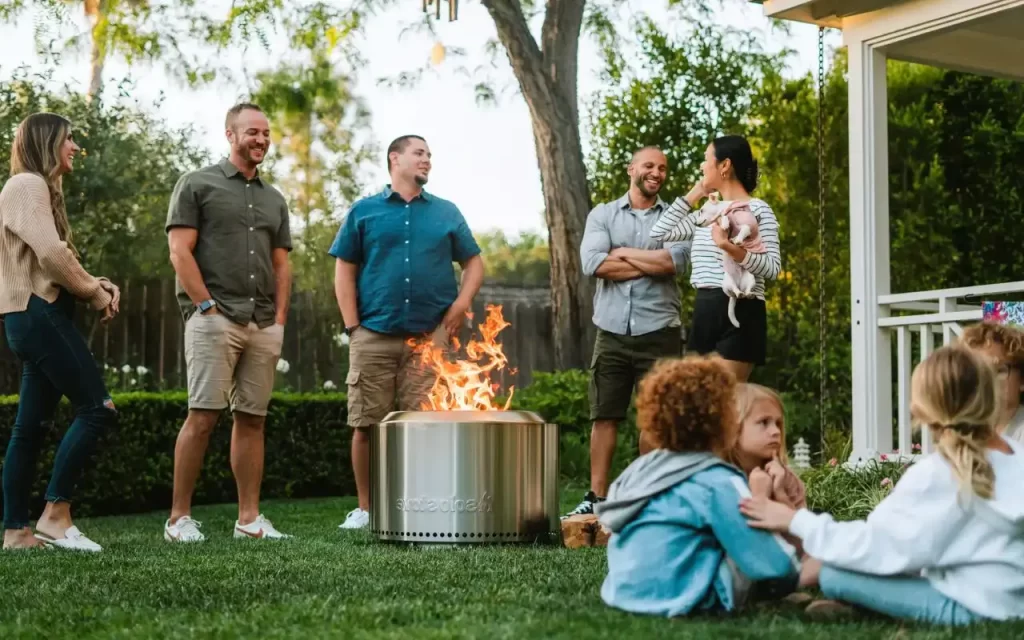Have you ever stepped out onto your deck, only to be enveloped in a cloud of smoke? If you’ve ever attempted to use a stove on a wooden deck, you know that it can be a challenge. Between the risk of sparks and the potential for damage to the deck, it’s no wonder that many people steer clear of using their stoves on their decks.
However, with a Solo Stove, you can enjoy the convenience of cooking on your deck without fear of damage or smoke. The unique design of the Solo Stove allows it to be used on any surface, including wood, without the risk of sparks or damage. In addition, the Solo Stove outputs very little smoke, making it the perfect choice for cooking on your deck.
If you’re still not sure whether or not you should use your stove on your deck, don’t worry. In this blog post, we’ll cover everything you need to know about using a Solo Stove on a wooden deck. We’ll also provide some tips on how to use your stove in the safest and most effective way possible. If you’re ready to learn more about using a Solo Stove on a wooden deck, keep reading!
Is it okay to use a solo stove on the wooden deck?

If you’re planning on using a solo stove on your wooden deck, you might want to think twice. While solo stoves are incredibly durable and easy to use, they can also be dangerous if not used properly. Here are three reasons why you should avoid using a solo stove on your wooden deck:
- The heat from the stove can damage the wood.
- There is a risk of sparks or embers escaping and causing a fire.
- The weight of the stove can leave marks or indentations in the wood.
If you’re looking for a way to enjoy your solo stove without damaging your deck, there are a few options. You can use a solo stove on a concrete patio or in your backyard. You can also purchase an outdoor oven or grill that is specifically designed for use on wooden decks. By taking these precautions, you can enjoy your solo stove without damaging your wood deck.
Can you use the tool stove on any type of deck wood?
Decks are a popular feature of many homes, providing a space for outdoor entertaining and relaxation. But when it comes to choosing the right type of decking material, there are many factors to consider.
One important question is whether or not you can use a stove on your deck. While some types of wood are suitable for this purpose, others are not. Here’s a look at the pros and cons of using a stove on different types of decking material.
Hardwood:
Hardwoods such as oak and maple are popular choices for decks because they’re durable and stylish. However, hardwoods are also susceptible to fire damage, so it’s important to use caution if you’re planning to use a stove on your deck. If you do decide to use a hardwood deck, be sure to choose a type that is pressure-treated to resist fire damage.
Softwood:

Softwoods like cedar and redwood are another option for decks. These woods are less expensive than hardwoods, but they’re also flammable. As such, it’s best to avoid using a stove on softwood decks. If you must use a stove, be sure to take precautions such as putting down a fireproof mat first.
Composite:

Composite decking materials are made from a mixture of wood fibers and plastic. This blend makes composite boards more resistant to fire than pure wood products. It’s important to use caution when using a stove on a composite deck.
In addition, some composite decking materials may emit harmful chemicals when exposed to heat, so be sure to check with the manufacturer before using a stove on your composite deck.
What to consider before using a solo stove on a wooden deck?
Before you break out the Solo Stove on your wooden deck, there are a few things to consider. Here are seven tips to keep in mind:
1. Check for sparks.

A solo stove can create a lot of sparks, so it’s important to make sure that there are no flammable materials nearby. This includes things like dried leaves or mulch, as well as any furniture or decorations made of plastic or other synthetic materials.
When you’re using the stove, be sure to keep a close eye on any sparks that escape. If you see a spark landing in an area that could catch fire, douse it with water immediately.because the last thing you want is for your deck to go up in flames.
2. Choose the right size.
Solo stoves come in a variety of sizes, so it’s important to choose one that is appropriate for your deck. Because a stove that is too small can be easily tipped over, and one that is too large can take up too much space.
However, keep in mind that If you have a large deck, you’ll need a larger stove; if you have a small deck, you’ll need a smaller stove. so make sure to choose the right size for your deck. In general, it’s best to choose a stove that is about the same size as your grill.
3. Consider the wind
Wind can be a major factor when using a solo stove on a wooden deck. If it’s windy, the flames can spread quickly and become out of control. To prevent this, make sure to position the stove in a way that blocks the wind. You can also build a windbreak out of bricks or stones to help keep the flames under control.
4. Be mindful of pets and children.

Pets and children can be curious about Solo Stoves, so it’s important to keep them away from the stove when it’s in use. If you have pets, make sure they are safely secured inside or in another area where they can’t get to the stove. And if you have young children, never leave them unattended near the stove.
5. Don’t forget about safety precautions.
Even though solo stoves are designed for outdoor use, it’s still important to take some basic safety precautions. Never pour gasoline or other flammable liquids on the fire, and always make sure that the area around the stove is clear of debris before lighting it.
These safety tips will help you avoid any accidents while using your stove. If you don’t take these precautions your deck could go up in flames and you would be putting your life and the lives of others in danger.
6. Use a fireproof mat

A fireproof mat is a type of mat that is designed to resist heat and flames. It’s a good idea to use one of these mats under your stove to protect your deck from any potential damage. Not only will it protect your deck from sparks and embers, but it will also help to prevent the fire from spreading if something does go wrong.
7. Keep a fire extinguisher handy
It’s always a good idea to have a fire extinguisher on hand when using any type of stove, including a solo stove. This way, you’ll be prepared in case of an emergency. Be sure to read the instructions on how to use it before you need it so that you’ll be able to use it quickly and effectively if a fire does break out.
By following these tips, you can help to ensure that your solo stove experience is safe and enjoyable. So go ahead and enjoy your next cookout with peace of mind, knowing that you’re taking the necessary precautions.
Does stolo stove get hot on the outside?
A stove is an appliance typically used to cook food. The heat from the stove transfers from the burner to the pot or pan, and then to the food. But does that heat travel beyond the pot or pan? Does the stove itself get hot on the outside?
The answer may seem obvious – of course, the stove gets hot on the outside! After all, it’s generating a lot of heat internally. But it’s actually a bit more complicated than that. While stovetops can certainly become warm to the touch, they don’t usually get as hot as one might expect.
There are a few reasons for this. First, most stoves are made with a material that conducts heat relatively slowly. This means that the heat has a hard time traveling from the inside of the stove to the exterior. Additionally, many stoves have some form of insulation between the inner workings and the outside world. This acts as a barrier, blocking some of the heat transfer.
So yes, stoves do get hot on the outside – but usually not as hot as you might think!
Frequently Asked Question
Q. What is the best way to clean a solo stove?
A. The best way to clean a solo stove is to use a mild soap and water solution. You can also use a dedicated stove cleaner, but be sure to follow the instructions carefully. Avoid using harsh chemicals or abrasive cleaners, as these can damage the finish of the stove. For stubborn dirt and grime, you may need to use a putty knife or other tool to scrape it off. Once the stove is clean, be sure to dry it completely before using it again.
Q. How often should I clean my solo stove?
A. How often you need to clean your stove will depend on how often you use it. If you use it regularly, you should aim to clean it at least once a month. If you only use it occasionally, you can probably get away with cleaning it less often.
Q. Can I use my solo stove indoors?
A. No, solo stoves are designed for outdoor use only. Using one indoors can be dangerous, as they produce a lot of heat and smoke. If you must use your stove indoors, be sure to open all the windows and doors to ventilate the area well. Additionally, keep a fire extinguisher handy in case of an emergency.
Q. What should I do if my solo stove catches fire?
A. If your stove catches fire, the best thing to do is to call the fire department immediately. In the meantime, try to extinguish the fire with a fire extinguisher if you can. Do not try to put it out with water, as this will only make the situation worse.
Conclusion
While it is possible to use a solo stove on a wooden deck, there are some things you should consider before making that decision. Always check with the manufacturer of your stove to make sure you are using the tool in the way it was intended. By following these simple tips, you can ensure the safe and enjoyable use of your solo stove on any surface, including a wooden deck. Have you used a solo stove on a wooden deck before? What tips would you share with others?


1 thought on “Can You Use a Solo Stove on a Wooden Deck?”